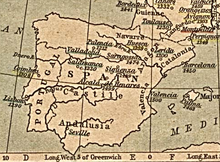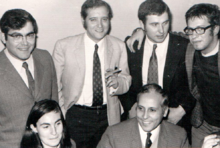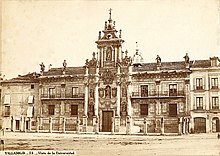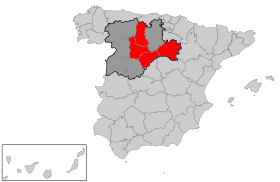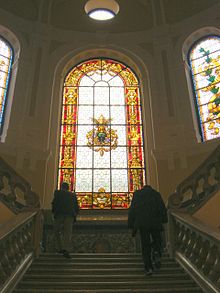University of Valladolid
The University of Valladolid (UVA) is a Spanish public university, located in the city of Valladolid. It was founded in the year 1241, which makes it the third oldest university in Spain, behind the University of Palencia and the University of Salamanca. However, it is claimed to be the oldest in Spain in accordance with the tradition of the Valladolid being the same institution as the General Study of Palencia, transferred between 1208 and 1241 to the city of Valladolid. He teaches undergraduate and postgraduate studies in different areas of knowledge. It has seven campuses distributed across four cities in Castilla y León: Valladolid, Palencia, Soria and Segovia (see Segovia Campus).
History
According to existing documents, the University of Valladolid already existed at the end of the 13th century. It was created by royal intervention, with the Valladolid council as an intermediary for the foundation, and received papal confirmation later, at the request of King Alfonso XI. There is a hypothesis that the university arose from the transfer of the General Study of Palencia, founded by Alfonso VIII of Castile, and Bishop Tello Téllez de Meneses between the years 1208 and 1241. Another hypothesis locates its origin in a private school or study with headquarters in the Abbey of Santa María la Mayor.
It has been an institution closely linked to the city since its inception, influencing its development due to the intense cultural and economic activity it promoted. During the 20th century, especially, and coinciding with an expansion in the number of students, as well as an expansion of studies and greater ease of access, the University is fully linked to historical and social events. Thus, the outbreak of the Civil War in 1936 led to the purge, and in some cases the execution of a significant number of professors and professors. In the same way, the University of Valladolid is configured, together with FASA-Renault, as the main pole of response to the dictatorial regime of General Franco, calling numerous strikes, concerts and acts of resistance and protest that culminated in 1974 with the government closure. of teaching activity, the only case in all of Spain (the academic year was organized in parallel, in private homes, parishes and public places).
The physical location was located, at first, in the Collegiate Church, later moving to the current location of the Faculty of Law, on the other side of the square.
It is represented during Holy Week in Valladolid in the University Brotherhood of Santo Cristo de la Luz, which worships one of the masterpieces of Gregorio Fernández, the Cristo de la Luz, which is located in the chapel of the Colegio Mayor Santa Cruz.
In the 1980s, the University undertook the construction of educational centers in the Barrio de La Rondilla, but later it sought to disperse it in different areas. Construction will begin later in the neighborhood of Belén and San Pedro Regalado. but the buildings on this campus do not have a clear relationship with the environment, due to the lack of a defined urban plan.
The Museum of the University of Valladolid, under the former direction of Jesús Urrea, has continued to reconstruct its history, history and heritage through articles and monographs.
Symbols
- Shield
According to the statutes of the University —published in the BOCyL on July 16, 2003— the heraldic description of the institution's coat of arms is as follows:
«Escudo de forma española en campo de plata, un oak de su color, terracedo y fruitdo en oro, acolado de dos keys en sotuer de oro y plata. To the bell, Royal kronor open of five blossoms seen surmounted from papal tiara with sparklings. »Statutes of the University of Valladolid. Chapter II. Article 8.1. Official Gazette of Castilla y León No. 136 of 16 July 2003
- Sello
The description of the stamp is as follows:
«Reproduces your shield bent or legend: (Cruz) Sapientia Aedificavit Sibi Domvm. »Statutes of the University of Valladolid. Chapter II. Article 8.2. Official Gazette of Castilla y León No. 136 of 16 July 2003
- Flag or pendant
The textual description of the flag is:
"The Flag or Pendon of the University of Valladolid is rectangular in shape, of dimensions 152 centimeters by 198 centimeters, in purple. In its center, the University Escudo in its enamels or colors. »Statutes of the University of Valladolid. Chapter II. Article 8.3. Official Gazette of Castilla y León No. 136 of 16 July 2003
- Colors
The corporate colors of the University of Valladolid are turquoise blue, defined by Pantone 654; and purple, defined by Pantone 207.
Facilities
Buildings
- Historical building. Faculty of Law
The first building of the University of Valladolid of which we have news of its architectural entity is the one built at the end of the 15th century, after the transfer of the institution from the Collegiate Church to its new location. It consisted of a four-sided cloister, to which the classrooms opened, and a late-Gothic chapel of some size. The cloister was entered through a doorway, also late Gothic, which opened onto Librería street. At the beginning of the 18th century, this building was insufficient, so it was extended with another quadrangular cloister, with four galleries, to which several classrooms built at the same time opened. Closing the complex to the Plaza de Santa María (today Plaza de la Universidad), an interesting Baroque façade was built, designed by the Carmelite friar Pedro de la Visitación and built in 1715. In it are different groups of quality sculptures that They represent allegories of the subjects that were taught in the building. It is worth noting the central body, organized by four giant columns and topped by a large comb. On the balustrade there are four sculptures that represent the kings who favored the Valladolid university.
This complex, made up of these two cloisters, the one from the XV century and the one from the XVIII, their respective classrooms and other outbuildings, such as the chapel or the clock tower —built in the 19th century—, survived until 1909.
In 1909, and with great controversy, it was decided to demolish the old building (including the XV century façade that was opened onto Librería street), to build a new building following eclectic lines and designed by the architect Teodosio Torres López. Only the Baroque façade designed by the Carmelite friar Pedro de la Visitación was saved from this demolition and it seems that the initial idea also contemplated its destruction. Teodosio Torres López's project proposed a university building with two cloisters, like the existing one. Its organization was carried out by means of a stairwell located between both cloisters and a large hall that opened onto Librería street. The façade of the university building facing this street was based on a reinterpretation of the Baroque façade by Pedro de la Visitación, but using decorative elements from Plateresque, Baroque, Neoclassicism and large openings typical of the hygienic mentality of the time. On one side of the façade was the observatory tower and on the other, the new clock tower that solved the corner between the Plaza de la Universidad and Calle Librería. The project had some unresolved problems: a grandiose representative façade was built on a narrow street such as Librería, so it was drowned, and the baroque façade was incorporated into the building in a very clumsy way. In 1939, this building suffered a fire. To alleviate the problem of integrating the Baroque façade into the Teodosio Torres López building, Constantino Candeira Pérez designed in 1939 a large staircase and lobby, following historicist lines, which are accessed through the Baroque façade. This staircase is a sample of the triumphalist and historicist architecture typical of the Spanish postwar period. In 1968 the last works that make up the current building were carried out, demolishing the second cloister and building a five-story building on its site to house the students, whose number had grown considerably in the sixties, collapsing the Teodosio building. Torres López, designed for a much smaller student body. In this same reform, the tower of the Teodosio Torres López observatory and the grandiose auditorium of 1909 were demolished. The façade of Librería street was also remodeled, losing the historicist clothing designed by Teodosio Torres López. The new auditorium was built flanking the façade of Fray Pedro de la Visitación on one of its sides.
- Higher Technical School of Architecture
It is built after a complicated genesis. Initially, in a building with a project by Antonio Fernández Alba, it was going to be the delegation of the Ministry of Education, in the Plaza de Poniente, next to the Núñez de Arce Institute. But, after the Superior Technical School of Architecture was awarded to the University, the brilliant project by Antonio Fernández Alba was maintained, moving it to the residential neighborhood of Huerta del Rey.
The building is endowed with a strong representative character, abandoning the organic forms of other Valladolid buildings of the time. An axis of symmetry is marked on the façade, which organizes the forceful volumes of the complex.
The extension also designed by Fernández Alba in the eighties, was already conceived for its function, without the spatial limitation that the initial project had. Greater freedom of organization is now being sought with a centralized plant.
- Faculty of Economic Sciences
The Faculty of Economic and Business Sciences, designed by the architects Salvador Gayarre Ruiz de Galarreta, Tomás Domínguez del Castillo and Juan Carlos Martín Baranda, is one of the buildings promoted by the University of Valladolid in the eighties. From its origin, the building was too small to accommodate the number of students required by the degree, so a few years later the construction of the Campus del Río Esgueva Lecture Room was built, adjacent to the faculty, and which provides services to the Faculty. Economic and Business Sciences and the School of Industrial Engineering.
The building is organized longitudinally, with a wide central corridor of various heights, which distributes and communicates the teaching and complementary spaces. The game established between the main hall, shaped like a classical theater, and the open-air theater arranged at the opposite end, fenced off and closed to the public, is interesting. The exterior view of the office section is reminiscent of a beehive.
However, various mistakes were made at the time of its construction. The plans were misinterpreted, so the orientation of the classrooms was not correct. The wide spaces of the building, as well as its original translucent roof, suitable in his idea for a climate like the Canary Islands, but not for the Castilian one, prevented the temperature from being correct throughout the building, leaving the heating useless, and thus turning the center is extremely cold in winter, and very hot in summer. Likewise, the original arcades on the west side became a source of dirt and garbage, which endangered the health of the center. The library expansion works solved these inconveniences.
Subsequent works managed to partially alleviate these and other defects, such as the absence of elevators and necessary access for people with disabilities.
- Palace of Santa Cruz
In the vicinity of the University, as the engine of development of the city and place of training for clergy and scientists, a multitude of institutions such as the Colegio Mayor Santa Cruz arise.
Cardinal Pedro González de Mendoza founded this school in 1482, the year in which he was named Archbishop of Toledo. With a solid intellectual background, he opened the doors to the Renaissance in the city, with a building first designed in Gothic, probably by Enrique Egas, but changed in 1490 to a Renaissance aesthetic by his order. But only the façade was adapted with the inclusion of decorative elements of the new style. In it, the central section stands out, with an Italian-inspired padding that covers the entire bottom, and the door decorated with grotesques. Also noteworthy is the cornice with balustrade that finishes off the main façade. These works were directed by Lorenzo Vázquez de Segovia. In the 18th century the façade was reformed, dating from that period the large neoclassical balconies, the work of the architect Manuel Godoy.
The building, with a quadrangular plan, is arranged around a three-story patio. The bass had to be rebuilt by Juan de Nates in 1603 due to the poor quality of the stone. The architect Domingo de Ondátegui reformed the two upper floors in 1744, although all these interventions respected the late Gothic approach of the cloister and its decorative motifs.
On the ground floor, the hall and the Sad Classroom stand out, covered with simple ribbed stone vaults, as well as the chapel, which is accessed through the hall through an ogival door. To reach the first floor, there is a wide neoclassical staircase, built in the second half of the 18th century. On this first floor, the library stands out, with a quadrangular floor plan and which completely occupies one of the pandas of the cloister. Its façade is closed with some wooden doors, the work of Alejo de Vahía. The interior is covered with a vault with lunettes. The bookcases date from the early 18th century century. The content of this library is very rich and important, with several dozen incunabula and numerous printed books from the 16th, 17th, 18th and 19th centuries, some of them coming from libraries of disentailed monasteries and convents.
Currently, the building houses the Rectorate of the University, the administrative headquarters of the Museum of the University of Valladolid (MUVa), and the headquarters of the Arellano Alonso Museum of African Art, whose collections of African art - donated to the University. they can be visited in the Hall of Rectors and the Renaissance Room of the Palace.
Libraries
The Library of the University of Valladolid has 14 service points, 3 are located in the provinces of Palencia, Soria and Segovia, while the rest are in Valladolid, to which group the following belong:
- The Historical Library of Santa Cruz
- The Reina Sofia Library
- The Architecture Library
- The Library of the European Documentation Centre
- The Library of Health Sciences
- The Trade Library
- The Law Library
- The Economics Library
- The Library of Philosophy and Letters
- The Library of Industrial Engineering
- The Miguel Delibes Campus Library
Each of the aforementioned service points has a director, the entire service is directed by the Director of the Library and coordinated by the Central Services.
Its collections are accessible through the Almena Catalog, Worldcat and the UvaDoc Repository, including 970,155 books, including its valuable ancient collection of 45,000 documents, including numerous incunabula and manuscripts from the 10th century, 16,000 titles of periodical publications, 21,342 titles of electronic journals, 965 electronic books, 66 databases, 47,695 non-book material and 33,103 theses and final projects (data from May 2012).
User services include: web portal, reading room, intercampus and interlibrary loan, loan (documentary collection, laptops, e-book readers, USB sticks), bibliographic information, user training, subject guides and tutorials.
The library is a member of: OCLC, Europe Direct, REBIUN, Dialnet, Catalog 17, ABBA, Documat, GEUIN, REDINED and BUCLE.
Museum of the University of Valladolid (MUVa)
The Museum of the University of Valladolid (MUVa) is basically made up of three collections:
- Collections of History and Art.
- Natural Science Collections.
- Collections of Biomedical Sciences.
Campus
Currently, the University of Valladolid has seven campuses:
- Valladolid Campus, in the city Valladolid, divided in turn into:
- Campus of Huerta del Rey
- Campus Centre
- Campus Río Esgueva
- Campus Miguel Delibes,
- University Campus Duques de Soria, in the city of Soria,
- Segovia Campus, in the city Segovia and
- Campus of Palencia, in the city Palencia.
Its more than 30,000 students are spread over 25 centers with more than 2,000 teachers and 1,000 "PAS" (Administration and Services Staff).
The current rector is Antonio Largo Cabrerizo, who began his position on Tuesday, May 2, 2018 as successor to the previous rector, Daniel Miguel San José.
It has, in addition to the 25 centers, a series of administrative buildings such as the Palacio de Santa Cruz where the rectory is located; or The Student House where the rest of the administrative services are located. The CTI (Information Technology Center) is located in the Alfonso VIII University Residence building next to the Faculty of Sciences.
Academic information
Organization
The University of Valladolid is organized into faculties and university schools. In the city of Valladolid, the University has four schools and eight faculties:
- School
- Computer engineering
- Industrial Engineering
- Higher Technical School
- Architecture
- Telecommunication Engineers
- Faculty
- Science
- Economic and Business Sciences
- Trade
- Law
- Education and Social Work
- Nursing
- Philosophy and Letters
- Medicine
Segovia Campus
On the Segovia Campus, the University of Valladolid has two faculties and a university school:
- Escuela Universitaria de Informática de Segovia
- Faculty of Education of Segovia
- Faculty of Social, Legal and Communication Sciences of Segovia
Palencia Campus
- Higher Technical School of Agricultural Engineering
- University School of Education
- Faculty of Labour Sciences
Soria Campus
- University School of Education
- Faculty of Nursing
- Faculty of Business Studies
- University School of Physiotherapy
- University School of Agricultural Engineering
- Faculty of Translation and Interpretation
Research
LOU Institutes
- Institute of Molecular Biology and Genetics (IBGM)
- Institute of European Studies
- Institute of Simancas History
- Instituto de Neurociencias de Castilla y León
- Institute of Applied Ophthalmobiology (IOBA)
- University Institute Center for Innovation in Chemistry and Advanced Materials (CINQUIMA)
- University Institute of Research in Sustainable Forest Management
- University Institute of Urbanistics
- Institute of Mathematics Research (IMUVa)
Institutes pending JCyL approval
- Institute of Pharmacoepidemiology (IFE)
- Institute Advanced Production Technologies (ITAP)
Research Centers
- European Documentation Centre
- Centro de Investigación de la Baja Atmósfera “José Casanova”
- Centro de Investigación de Endocrinología y Nutrición Clínica
- Centro de Investigación en Terminología Bilingüe, Traducción Especializada y análisis Contrastivo (CITTAC) de la Universidad de Valladolid
- Azucarera Technology Centre (CTA)
- Centro Superior de Ciencias Médicas
- Centro Transdisciplinar de Investigación en Educación (CETIE-UVa)
- University Center for Alcohol and Drug Studies
Technology Centers
- Regional Centre for Telecommunications Development (CEDETEL)
- Fundación Centro Tecnológico de Cereales (CETECE)
- Transport and Energy Research and Development Centre (CIDAUT)
- Automation Center, Robotics, Information and Manufacturing Technology (CARTIF)
- Centro Tecnológico Agrario y Alimentario (ITAGRA)
Research chairs
- Alcón Chair
- Chair of Renewable Energy
- Chair of Hispanic Studies "Antonio Fernández y Eusicinia González"
- Chair Jorge Guillén, born of the collaboration between the Jorge Guillén Foundation and the University of Valladolid.
- Chair Michelin
- Juan de Villanueva Chair
- Topcon Chair
- Renault Consulting Chair of Industrial and Business Excellence
Research laboratories
- Electrical Calibration Laboratory of Castilla y León (LACECAL)
- Mapping and Geographic Information Systems Laboratory
- Laboratory of Industrial Essays of Castilla y León (LEICAL)
- Photogrammetry Laboratory
- Dimensional Metrology and Calibration Laboratory (LCD)
- Metrology and Temperature Calibration Laboratory (TERMOCAL)
- Ventilation Laboratory HS3
Recognized Research Groups
The university has more than a hundred recognized research groups, which work in the areas of: Humanities, Social and Legal Sciences, Experimental Sciences, Engineering and Technology, and Biomedical and Health Sciences. Some of the groups most relevant:
- Energy and System Dynamics Group: Conducts studies on energy-centred environmental issues and system dynamics, analyzing the complex relationships between variables that influence sustainability and development. Among his works is a Integrated System Simulation Model Energy-Economy-Climate Change for Spain, commissioned by the Ministry of Science and Innovation, for which they use the methods used in the series of reports for the Club of Rome: The limits of growth.
- Grupo de Sistemas Inteligentes y Cooperativos / Educación, Medios, Informática y Cultura (GSIC/EMIC)
- Atmospheric Optics Group (GOA-UVa): It is dedicated to the study of atmospheric components such as water vapor, ozone, aerosols and clouds through optical methods. It also manages an AERONET global network photometer calibration centre created by NASA and Lille University. The GOA-UVa calibration centre is part of the European ACTRIS research infrastructure.
Central research support services
- Animals
- Laboratory of Instrumental Techniques (LTI)
- Secretariado de Publicaciones e Intercambio Editorial
Science Park
- Science Park Plan of the University of Valladolid
- Information notebook of the Science Park
- Recruitment Profile
PAVES Program
The PAVEs (Business-Linked Associate Professors) program at the University of Valladolid (co-financed by the regional government of Castilla y León) represents an important experience in teaching innovation. It began in 2001 and is made up of 50 associate professors who come from the business world, all of them from the technical or engineering field. In fact, half of the PAVEs hired at the University of Valladolid are attached to the Higher Technical School of Engineering. Informatics well to the Higher Technical School of Telecommunications Engineers. They teach at the company's facilities, given that the main objective is for education to be mainly practical and/or oriented towards the most advanced technologies demanded by companies. The education is either the practical part of the official subjects or complete subjects, normally electives/free configuration.
Participating companies
- Telefónica I+D
- Fundación CIDAUT, Centro de Investigación y Desarrollo en Transporte y Energía [www.cidaut.es]
- OTHER
- Cartif
- Tecsidel
- GMV
- Cedetel
- Microser
- Nestlé
- Johnson Controls
- Indalux
- Electrical Network of Spain
- Iberdrola
- Algor
- Aguas Valladolid
- Fremap
Monitoring of the program "The Green Deserts"
The University of Valladolid participates in the ambitious project "Los Desiertos Verdes" which is a reforestation project with the participation and support of the " Life+" of the European Union using the Groasis Waterboxx device on 63 hectares in 5 different provinces of Spain (Valladolid, León, Zamora, Zaragoza and Barcelona). All the areas included in the project are different due to their: climate, soil types, height, current use (uncultivated land, dump, ski area, burned forest, agriculture) and native trees. The common element for all is that they are very dry, even arid.
Schools/Colleges
- Higher Technical School of Computer Engineering
- Higher Technical School of Telecommunication Engineers
- Higher Technical School of Industrial Engineering
- Polytechnic University School
- Faculty of Sciences
- Higher Technical School of Architecture
- Faculty of Law
- Faculty of Philosophy and Letters
- Faculty of Economic and Business Sciences
- Faculty of Education and Social Work
Departments
- Geography
- Materials Science and Metallurgical Engineering, Graphic Expression in Engineering, Cartographic Engineering, Geodesy and Photogrametry, Mechanical Engineering and Manufacturing Process Engineering
- Architectural Constructions, Field Engineering and Mechanics of Continuous Media and Structure Theory
- Applied economy
- Electricity and Electronics
- Statistics and Operational Research
- Applied Physics
- Computer Sciences, Computer Sciences and Artificial Intelligence, Language and Information Systems
- Systems and Automatic Engineering
- Electrical engineering
- Energy and Fluidomechanical Engineering
- Chemical Engineering and Environmental Technology
- Spanish language
- Organization of Business and Marketing and Market Research
- Pedagogy
- Sociology and Social Work
- Signal Theory and Communications and Telematic Engineering
Traditions and culture
Within the university there are cultural associations of all kinds: musical, theatrical, student...
It thus has a young orchestra: the Youth Orchestra of the University of Valladolid (JOUVa). It is formed and managed for the most part by students of the University. It is based in the Alfonso VIII University Residence in Valladolid. Currently (2010), and since its foundation in 1998, its artistic and musical director is Francisco Lara Tejero.
The University of Valladolid has a great tradition of Tunas, of which there are journalistic references from the XIX century. In 1997, the six tunas that existed at that time recorded a CD, although today only the Tuna de Económicas and the Tuna de Derecho de Valladolid survive.
In addition, it also has a choral group, the Coro Universitario de Valladolid directed by Marcos Castán and an Early Music Group directed by Ignacio Nieto Miguel
Although these formations have independent programs, they perform joint concerts for certain shows.
There is also a theater group: Gente de Teatro de la UVa founded in 1984 under the name Gente de Teatro de la Facultad de Medicina which, from 1998, it became the official theater group of the University. Its director is Carlos Burguillo.
Through the Extension and Culture area, the University presents multiple cultural programs throughout the year, sometimes with various organizations (such as the National Museum of Sculpture) standing out popularly in the summers UniversiJazz and the Santa Cruz Festival. It also collaborates in all the concerts that are organized through each University Association or each Vice-Rector's Office and with a wide variety of both public and private associations. The University of Valladolid also supports religious-cultural initiatives such as those developed by the University Brotherhood of Santo Cristo de la Luz, in which it is worth mentioning the Christmas and Passion Plays.
Sports
The Sports Service of the University of Valladolid has the mission of promoting physical activity and sports among members of the university community. The center has the Fuente La Mora sports complex in Valladolid and also has sports facilities on the Palencia, Segovia and Soria campuses.
The UVA has teams that participate in Spanish federated competitions, under the aegis of the Universidad de Valladolid Sports Club. Previously, its teams competed under the name of the Valladolid University Sports Center, being popularly known by the acronym CDU Valladolid or as University of Valladolid.
Throughout its history, the University of Valladolid has achieved several successes in national championships. Among the most notable teams is the rugby team, which in the 1973-74 season debuted in the highest category of the National League by acquiring the federative rights of another team from Valladolid, CR El Salvador. CDU Valladolid had 14 seasons in the Division of Honor of Rugby, managing to remain in the elite practically uninterruptedly until 1989, except for a hiatus from 1982 to 1984 motivated by the restructuring of the competition. His greatest successes at this time were in the Copa del Rey, with two runners-up (1975 and 1985). In 2008 UVA abolished the rugby team and most of its players created the Vallisoletano Moreras Rugby Club, active until 2013.
In women's handball, the late Universitario de Valladolid played several seasons in the highest category of the league, the Honor Division, achieving its best classification in the 1988-89 season with a third place. A year later he was proclaimed runner-up in the Copa de la Reina. International and Olympic players such as Paloma Arranz and Blanca Martín Calero emerged from the ranks of this team. In men's handball, it currently has a team that plays in the First National Division.
In volleyball, the UVa teams play in the Superliga-2, both for men and women, although in the past they competed in the highest category of the Spanish league. In basketball, it has a men's team in the EBA League, which in the 1970s came to participate in the extinct Second Division (second level of the National League, before the creation of the ACB League). UVa accumulates seven presences in the national category, all of them in the Third Division of Spain.
Doctors Honoris Causa
The list of honorary doctors from the University of Valladolid, started in 1964 with its first investiture, includes more than sixty distinguished people.
Contenido relacionado
Governor Virasoro
Tampere University
University of Vienna
